Cultural landscape
Venetz a trobar-nos!
The Cultural Network
The Maira, Grana, and Stura Valleys are home to an array of museums, exhibitions, and cultural entities that safeguard a heritage emblematic of the Occitan language, history, arts, knowledge, and the passions of the local communities. This network forms an exceptional cultural fabric of significant anthropological value. Venetz a trobar-nos! (Come and visit us!)
This warm invitation is extended in Occitan, a Romance language evolved from Latin. Its origins trace back to the 11th century when troubadours roamed the European courts. Today, it endures in the south of France, in Val d’Aran in Spain, and across fourteen valleys in Piedmont, including the Maira, Grana, and Stura Valleys, and in parts of Liguria and Calabria.
Museo Sòn de Lenga – Espaci Occitan
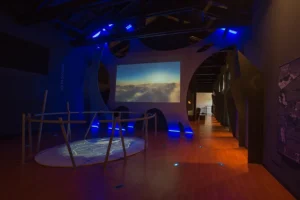
Address: Via Val Maira 19, Dronero
Collection: Allow the Sòn de Lenga to guide you through the Espaci Occitan Association museum. Celebrated as an exemplar of Occitan culture and an interpretative hub of the territory, as well as a pivotal visitation site for the valleys where the Òc language thrives, it offers an engaging and dynamic exploration of the extraordinary literary, musical, folkloric, and historical traditions of the Italian Occitan domain.
For further information: espaci-occitan
Luigi Mallé Civic Museum
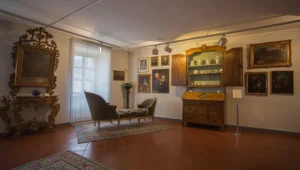
Address: Via Valmala 9, Dronero; Established in 1995
Collection: Nestled at the gateway to the Maira Valley lies Dronero, a quaint medieval village rich with heritage. Among its labyrinthine streets, grand noble palaces, and vestiges of ancient city walls stands the former abode of Luigi Mallé, now a museum. Mallé, an art historian and erstwhile Director of the Royal Museums of Turin, was a prolific collector of art and sculptures. His legacy to the town of Dronero is a trove of collected works spanning across centuries.
From Meissen porcelain to Gallé and Daum art nouveau vases, Flemish paintings to archival photographs, landscape art of the 19th century to masterpieces by 20th-century luminaries such as Fontana, the Museum harbours four centuries of artistic narrative.
For further information: www.museomalle.org
Permanent Exhibition of Sacred Art
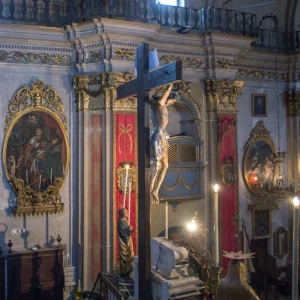 Address: Via XXV April, Dronero
Address: Via XXV April, Dronero
Collection: Tucked away in the historic heart of Dronero, just beyond the magnificent Piazza Manuel di San Giovanni, lies the secluded Church of the Gonfalone. Reconstructed in the early 18th century with a flourish of Baroque elegance, its grandeur captivates visitors. Yet, the true marvel resides within the adjoining spaces, corridors, and rooms flanking the central nave. Here, the Sacred Art exhibition pays homage to the centuries-long legacy of the Brotherhood of the Disciplined, later known as the Gonfalone, established in the 12th century and still active to this day.
“G. Goletti” Musical Instrument Collection
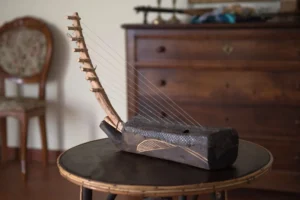 Address: Via XXV April, Dronero
Address: Via XXV April, Dronero
Collection: Facing the Church of the Gonfalone, within the historic Palazzo Savio, a late 18th-century edifice, rests a remarkable assemblage of 150 musical instruments from across the globe. Bequeathed by Mrs Goletti-Wahn, this collection was lovingly accumulated by Giovanni Battista Goletti, a native of Dronero. His extensive travels as a senior Court of Auditors official fuelled his profound musical ardour. A tour of this museum promises an auditory journey from the outback of Australia to the shores of California, and from Central Africa to the steppes of Mongolia, encapsulating a symphony of world cultures.
For further information: www.istitutomusicaledronero.it
Giovanni Giolitti European Centre
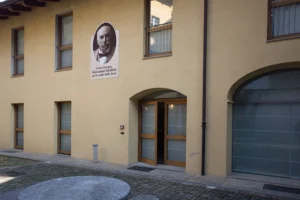 Address: Via XXV April 25, Dronero
Address: Via XXV April 25, Dronero
Collection: The Giovanni Giolitti European Centre forms a cultural triumvirate within a stone’s throw of Palazzo Savio and the Church of the Gonfalone. Established in 1998 through a generous endowment from the town of Dronero, the centre celebrates and explores the life of Giovanni Giolitti, a seminal early 20th-century figure from the Maira Valley. Since its inception, the Centre has broadened its scope, orchestrating an array of national events, including conferences, seminars, lectures, exhibitions, and scholarly publications.
For further information: www.giovannigiolitti.it
Rocceré Visitor Centre
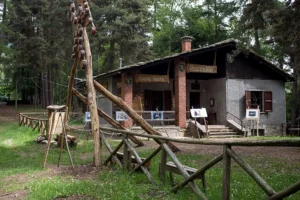 Address: B.ta Sant’Anna, Roccabruna
Address: B.ta Sant’Anna, Roccabruna
Collection: At the gateway to the Maira Valley, Roccabruna is a custodian of one of Europe’s most significant Bronze Age rock art sites. Atop Monte Rocceré, dominating the plains below, over 35,000 cupules — artificial hemispherical cavities etched into the rock — serve as silent witnesses to the valley’s earliest settlements. Before ascending Monte Rocceré, a visit to the Rocceré Visitor Centre is indispensable. Nestled within the tranquil pine forest of Sant’Anna di Roccabruna, the centre houses a comprehensive compendium of the archaeological area’s history and studies.
For further information: www.coppelleroccere.com
‘I Bottai’ Visit Point
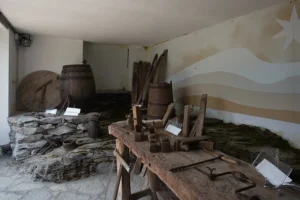 Address: B.ta Serremorello, Macra
Address: B.ta Serremorello, Macra
Collection: The venerable municipal palace of Albaretto, once a hub of political and social life in Macra, now chronicles the bygone era of a vanished craft. ‘I Bottai’ Visit Point is dedicated to the Bottai (coopers) who hailed from Albaretto, wandering craftsmen who would depart in autumn to construct or mend wooden vats essential for the fermentation of renowned wines like Barbera, Barbaresco, and Dolcetto across the farmhouses of Langhe, Monferrato, and Monregalese.
For further information: ecomuseoaltavallemaira.it
Seles – Museum of Itinerant Trades
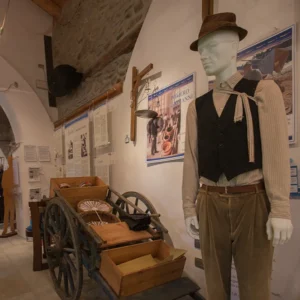 Address: Borgata Chiesa, Celle Macra
Address: Borgata Chiesa, Celle Macra
Collection: The rugged winters of the mountains birthed a myriad of professions, now extinct, forged out of necessity and ingenuity, such as the acciugai (anchovy merchants). The Seles Museum of Itinerant Trades, located in the historic Chapel of San Rocco, recounts the trials and tribulations of these merchants, whose trade was as unexpected as it was common in a land so distant from the sea.
The museum not only retraces the merchants’ journeys but also examines the historical, anthropological, and sociocultural identity of the middle Maira Valley. It stands as a repository of the legacies and documents of all the valley’s anchovy merchants, originating from Dronero, Celle di Macra, Paglieres, and Macra.
‘Spazio Pinse’ Exhibition Point
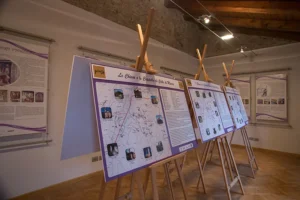 Address: B.ta Serremorello, Macra; 2005
Address: B.ta Serremorello, Macra; 2005
Collection: The ‘Pinse’ were itinerant artists who traversed the valleys, and ‘Spazio Pinse’ is the exhibition space that preserves evidence of their legacy. Situated above the rectory of the Parish Church of San Giovanni Battista, the exhibition spans the works of painters from the 15th to the 19th century in the Cuneo Alps, narrating the artistic fervour and vibrancy of a valley that thrived as a cultural nexus.
Pels Museum
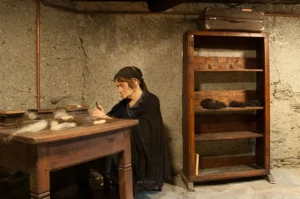 Address: Borgata Serre, Elva
Address: Borgata Serre, Elva
Collection: In Elva, one of Italy’s smallest municipalities nestled in the Upper Maira Valley, a quaint museum commemorates the distinct vocation of hair collectors from the Maira Valley mountains, whose efforts supplied esteemed hairdressers across Europe.
For further information: www.vivaelva.it
Hemp and Women’s Work Museum
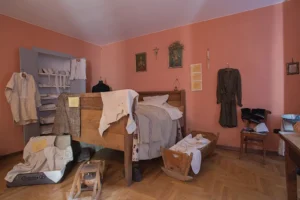 Address: Via Nazionale 9, Prazzo
Address: Via Nazionale 9, Prazzo
Collection: In the Maira Valley, hemp was a pivotal resource, emblematic of labour and the feminine contribution to mountain life. The museum showcases the process of hemp work and its myriad applications, celebrating the significant role of women in the valley’s social fabric.
Visitors to the museum will experience the profound impact of the female figure within the family and appreciate the adversities they overcame.
Il Filatoio – Piedmontese Silk Mill Museum
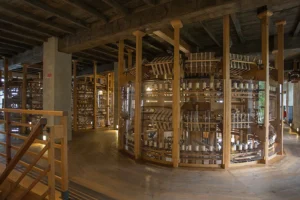 Address: Via Giacomo Matteotti 40, Caraglio
Address: Via Giacomo Matteotti 40, Caraglio
Collection: The silk mill, located on the outskirts of Caraglio near the route to Dronero, is a testament to 18th-century industrial archaeology. It stands as the oldest silk manufacturing complex in Europe, where both reeling and twisting operations were integrated. Visitors can admire the meticulously reconstructed silk production machinery, ranging from the small furnace used for treating cocoons to the reeling and twisting machines. A highlight is the imposing hydraulic silk twisting machines, modelled on the Bolognese system. The restored machinery, dating from the mid-17th to the 18th century, is presented in its original setting using authentic materials.
For further information: www.filatoiocaraglio.it
Fossil Exhibition
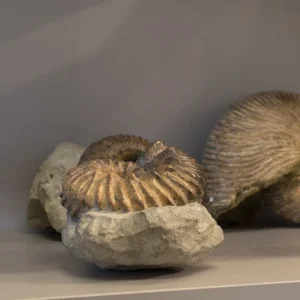 Address: via Divisione Cuneense n. 65, San Rocco Bernezzo (CN)
Address: via Divisione Cuneense n. 65, San Rocco Bernezzo (CN)
Collection: Nestled within a farmhouse in Bernezzo, the exhibition encapsulates Attilio Dalmasso’s 50-year passion for fossils. Presented chronologically across nine showcases and five racks, the collection showcases almost 600 fossil specimens, tracing life from the Precambrian era to the Anthropocene, and offering insights into some of the earliest life forms.
For further information: www.passionefossili.it
Kinomuseo
 Address: Via Roma 17, Valgrana
Address: Via Roma 17, Valgrana
Collection: At the heart of Valgrana lies a quaint cinema museum, the culmination of a 40-year collection now boasting 10,000 items. The KinoMuseo displays an array of cinema memorabilia, including posters, magazines, photographs, and various pre-cinematic devices such as magic lanterns and zoetropes.
The archive also comprises over 3,000 periodicals from around the world and more than 600 books dedicated to the history and art of cinema.
For further information: www.kinokinino.com
Terra del Castelmagno Ecomuseum – I Babaciu
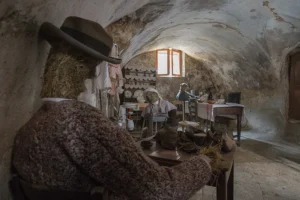 Address: San Pietro di Monterosso Grana
Address: San Pietro di Monterosso Grana
Collection: Established in 2013, the ‘Il Paese Senza Tempo’ (‘Timeless Village’) route offers a glimpse into a past preserved by life-size ‘babaciu’, figures made of iron and hay that symbolise the blend of tradition, memory, and community. Since June 2019, this journey through time has been augmented with the oral histories of San Pietro’s residents, accessible via special listening sticks that relay ten distinct historical narratives, connecting visitors to the people, stones, and the famous Castelmagno cheese. Each tale is anchored in personal accounts, imbued with a poignant message.
For further information: www.terradelcastelmagno.it
Terra del Castelmagno Ecomuseum – the museum
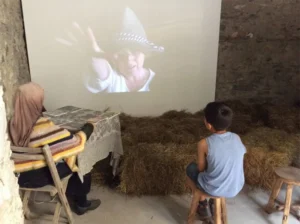 Address: Fraz. San Pietro n. 89, Monterosso Grana
Address: Fraz. San Pietro n. 89, Monterosso Grana
Collection: The Terra del Castelmagno Museum serves as an interpretative hub for the ecomuseum, reflecting the local community’s efforts in heritage curation – the same community behind the ‘Timeless Village’. It offers an expansive view of the Upper Grana Valley and its evolution over time. The museum narrates the collective tale of the region, showcasing the hidden historical and cultural assets of the valley.
Its mission is to unlock an understanding of the land through an integration of technology, gamification, and storytelling. A suite of installations, interactive technologies, and informative panels guide visitors through a treasure trove of knowledge passed down through generations.
For further information: www.terradelcastelmagno.it
Casa Narbona Museum
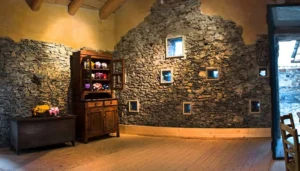 Address: Fraz. Campomolino, Castelmagno
Address: Fraz. Campomolino, Castelmagno
Collection: The Casa Narbona Museum captures the evocative and enigmatic history of the Narbona Hamlet, deserted in the 1960s by its inhabitants, leaving behind the artefacts of their everyday life. The museum displays materials and original objects salvaged from the now-dilapidated homes.
Museum of Life Up Here
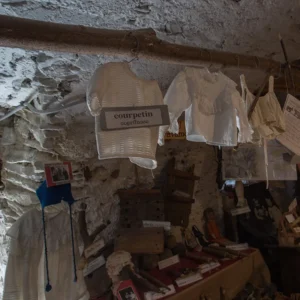 Address: Fraz. Colletto, Castelmagno
Address: Fraz. Colletto, Castelmagno
Collection: Situated in Fraz. Colletto of Castelmagno, the ‘Museum of Life Up Here’ gathers artefacts and tools that illustrate the daily routines and labour of yesteryear. The collection, from work implements to recreational and domestic items, is carefully conserved within the hamlet’s rooms and alcoves.
For further information: www.museocollettocastelmagno.it
Shepherding Ecomuseum, Na Draio per Vioure museum path in Pontebernardo
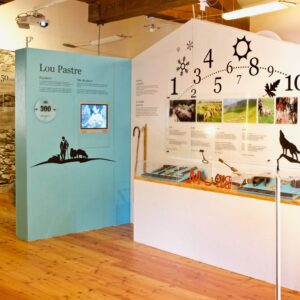 Address: Frazione Pontebernardo, Pietraporzio
Address: Frazione Pontebernardo, Pietraporzio
Collection: The ecomuseum chronicles, preserves, and protects the enduring legacy of the Sambucana sheep breed, indigenous to the valley and once on the brink of extinction in the 1980s. It also fosters the reclamation of the valley’s pastoral culture and its historical connections with the French Crau.
For further information: www.ecomuseopastorizia.it
Valle Stura Documentation Centre
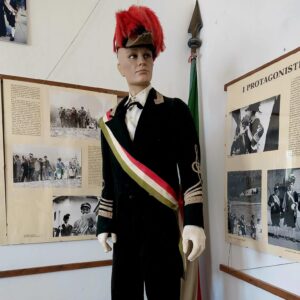 Address: Via Umberto I 50/a, Sambuco
Address: Via Umberto I 50/a, Sambuco
Collection: Since its inauguration in 1988 within the old Sambuco primary school, the Centre has dedicated itself to archiving records, advancing research, contributing to the safeguarding of the valley’s historical and cultural assets, and orchestrating activities that celebrate its rich heritage.
Albertino Fort of Vinadio
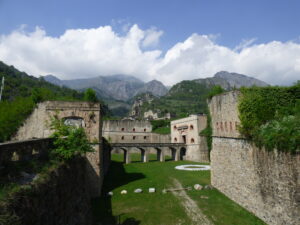 Address: Piazza Vittorio, Vinadio
Address: Piazza Vittorio, Vinadio
Collection: The Fort of Vinadio stands as a prominent example of military architecture in the Alps. Established in the 19th century by King Carlo Alberto, it showcases engineering and military prowess. Now transformed from a bastion of defence to a cultural venue, the Fort hosts’ Montagna in Movimento’ (‘Mountains in Motion’), a museum journey that immerses visitors in the Southern Alps’ history through multimedia displays, echoing the region’s enduring dynamism and interchange of people, ideas, and innovations.
For further information: www.fortedivinadio.com
Borelli Palace and Lalla Romano Space
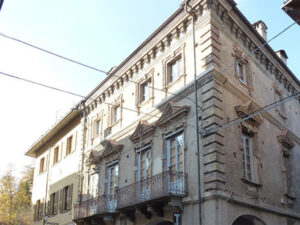 Address: Via Martiri e Caduti per la Libertà 1, Demonte
Address: Via Martiri e Caduti per la Libertà 1, Demonte
Collection: In the heart of Demonte, the Borelli Palace conserves the legacies of two eminent valley personas. The first two rooms are dedicated to the remembrance of Graziella Romano (aka Lalla Romano), a notable 20th-century writer from Demonte, while the subsequent rooms exhibit porcelain artistry by the local artist Luciana Magrini.
Maraman – Cultural Landscape of the Occitan Valleys
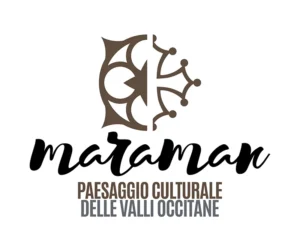 ‘Maraman’ is an Occitan adverb meaning ‘suddenly, surprisingly’. Reflecting this sense of discovery and wonder, the museums and exhibition spaces of the Maira and Grana Valleys unite to portray a comprehensive cultural landscape that distinguishes these Occitan territories of southwestern Piedmont.
‘Maraman’ is an Occitan adverb meaning ‘suddenly, surprisingly’. Reflecting this sense of discovery and wonder, the museums and exhibition spaces of the Maira and Grana Valleys unite to portray a comprehensive cultural landscape that distinguishes these Occitan territories of southwestern Piedmont.
Together, they narrate a tale of timeless significance, depicting the life and essence of the region: its enduring agricultural-pastoral traditions, the Occitan language and heritage, the ingenuity in harnessing extraordinary resources, and the creation of nomadic professions born from the necessity to venture beyond.
For further information: www.espaci-occitan.org
Còde Mistà
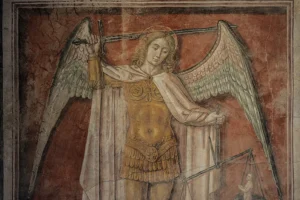 ‘Còde Mistà’ is an inventive resource for exploring the artistic sites within the Mistà network. Should you encounter a closed Mistà church, simply scan the QR Code with your smartphone to access detailed information, audio descriptions, and explore the site virtually in various languages.
‘Còde Mistà’ is an inventive resource for exploring the artistic sites within the Mistà network. Should you encounter a closed Mistà church, simply scan the QR Code with your smartphone to access detailed information, audio descriptions, and explore the site virtually in various languages.
For those planning from home, seize the chance to arrange a visit to the Mistà landmarks scattered across the four Occitan valleys of the ancient Marquisate of Saluzzo!
For further information: www.codemista.org